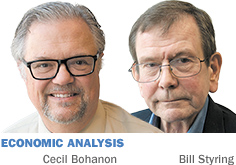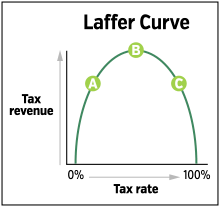Subscriber Benefit
As a subscriber you can listen to articles at work, in the car, or while you work out. Subscribe Now
 Presidential candidates are trotting out their tax plans. A focus inevitably becomes: How does this affect the top 1 percent? Before opening their mouths any further, they should all study what economists call the Laffer Curve. The LC relates tax rates to tax collections and demonstrates that sometimes raising tax rates results in lower tax collections and vice versa. Sound confusing? Read on.
Presidential candidates are trotting out their tax plans. A focus inevitably becomes: How does this affect the top 1 percent? Before opening their mouths any further, they should all study what economists call the Laffer Curve. The LC relates tax rates to tax collections and demonstrates that sometimes raising tax rates results in lower tax collections and vice versa. Sound confusing? Read on.
The accompanying graph shows the relationship between the income tax rate and tax collections from Americans with earnings of more than $500,000. We know two points for certain. If the tax rate is zero, no taxes are collected. Anything times zero is zero. At a 100 percent tax rate, also no taxes are collected. Why generate taxable income if the government takes it all?
In between, at rates between zero and 100 percent, we know government collects income taxes. Therefore, there must be some rate B greater than 0 percent but less than 100 percent that maximizes tax collections from the rich.
 As a matter of pure mathematics, there must be some range where increasing the rate causes tax collections to fall—every rate to the right of B in our figure. Conversely, if you’re to the right of B, cutting the rate moving left along the horizontal axis will actually increase collections.
As a matter of pure mathematics, there must be some range where increasing the rate causes tax collections to fall—every rate to the right of B in our figure. Conversely, if you’re to the right of B, cutting the rate moving left along the horizontal axis will actually increase collections.
Tax rates affect the tax base in two ways: Higher rates decrease incentives to generate income and also divert income and investment to less productive tax shelters. With higher rates, the tax base is smaller than it would otherwise be. Rates A and C generate the same revenue, but if our choices are points A or C, shouldn’t we all prefer lower rate point A?
The Laffer Curve teaches that trying to soak the rich through high tax rates can backfire (e.g., moving right from B). The rich might wind up paying less in tax dollars. Is this currently the case for the top 1 percent of income earners? We don’t know, but with a top rate of 39.6 percent, those at the federal level proceed with caution.
Candidates, are you listening?•
__________
Bohanon is a professor of economics at Ball State University. Styring is an economist and independent researcher.
Please enable JavaScript to view this content.
